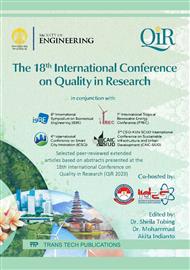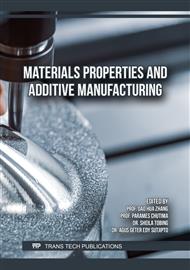p.9
p.21
p.29
p.41
p.53
p.63
p.71
p.81
p.87
Corrosion and Microstructure on the Casting Product Propeller Shaft Model of Al6063 Aluminum Alloy Base Materials
Abstract:
Aluminum materials are used in a wide field for household appliances, aircraft, cars, ships, and construction. This research aims to obtain a new material based on aluminum magnesium silicon (AlMgSi) alloy as an alternative material to replace the steel base material in the shaft propeller product. In this paper, we will use the die-casting method to investigate corrosion resistance and the microstructure of the propeller shaft with AlMgSi aluminum alloy base material. The main base material used is 6063 aluminum alloy, with variations in the addition of Si (1, 2, 4 wt%). Alloy Al6063 is heated to a temperature of 720°C to reach a complete liquid state. Then the temperature is lowered to 645°C, then the Si element is inserted into the heating furnace and stirred. Then the temperature is lowered to 615°C, then the Mg element is added, then stirred thoroughly by a mechanical stirrer. The rotational speed of the stirrer is 70 rpm and the stirring time is 240 seconds. They were then heated to a pouring temperature of 680°C. The mold is heated to a temperature of 265°C. Then poured into the mold and pressed 7 MPa. The cast is cooled at room temperature. Then the casting products were heat treated with a solution treatment temperature of 485°C for 3600 seconds and quenched. After that, the casting products were treated with artificial aging. The results of this study show corrosion resistance increases along with the addition of variations of Silicon. The highest corrosion rate was obtained by adding Si as much as 4 wt% of 511.28 mm/y. With the addition of variations of Silicon 0 wt%, 1 wt% and 2 wt% showed the corrosion rate of 173.35 mm/y, 201.60 mm/y, 233.49 mm/y. The microstructure shows differences in grain structure. materials with variations of si 0 wt% and materials with variations of si 0 wt%, 1 wt%, 2 wt% and 4 wt% have different grain sizes. The intermediate phase (Mg2Si) was mostly formed at Si 4% wt variation. So this study proves that adding silicon elements can increase grain sizes and refiner the propeller shaft.
Info:
Periodical:
Pages:
53-61
Citation:
Online since:
February 2024
Keywords:
Price:
Сopyright:
© 2024 Trans Tech Publications Ltd. All Rights Reserved
Share:
Citation:



